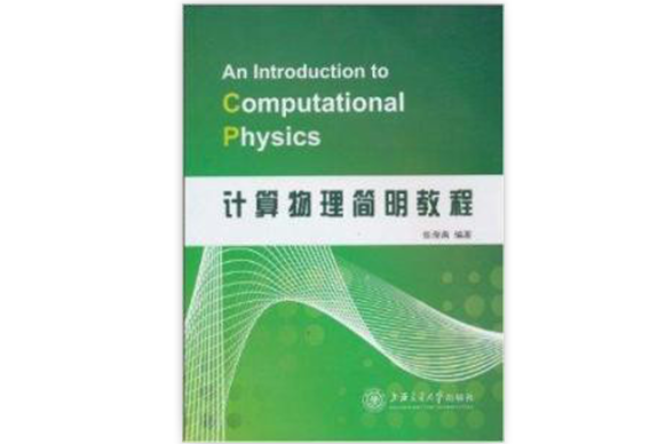《計算物理簡明教程》是2010年8月1日由上海交通大學出版社出版編著的實體書。《計算物理簡明教程》介紹了“計算物理”學科中的幾種基本常用方法,具體內容包括,誤差分析、有限差分和內插法、數值積分方法、矩陣算法、常微分方程差分解法、偏微分方程解法、蒙特卡羅模擬方法等。《計算物理簡明教程》可供物理專業的本科生作為“計算物理”課程教材使用,也可供從事數值計算的相關專業的研究生參考。
基本介紹
- 書名:計算物理簡明教程
- ISBN:7313066686, 9787313066688
- 頁數:259
- 出版社:上海交通大學出版社
- 出版時間:第1版 (2010年8月1日)
- 裝幀:平裝
- 開本:16
- 尺寸:22.8 x 16.8 x 1.4 cm
- 重量:399 g
內容簡介,目錄,
內容簡介
《計算物理簡明教程》是2010年8月1日由上海交通大學出版社出版編著的實體書。《計算物理簡明教程》介紹了“計算物理”學科中的幾種基本常用方法,具體內容包括,誤差分析、有限差分和內插法、數值積分方法、矩陣算法、常微分方程差分解法、偏微分方程解法、蒙特卡羅模擬方法等。《計算物理簡明教程》可供物理專業的本科生作為“計算物理”課程教材使用,也可供從事數值計算的相關專業的研究生參考。
目錄
Approximations, Errors and the Taylor Series
1. 1Approximations and Errors
l. 1. 1Approximations
1.1.2Round-off Errors
1. 1.3Principles to Hold During the Numerical Calculations
1.2Truncation Errors and the Taylor Series
1.2. 1Truncation Errors
1.2.2The Taylor Series
1.2. 3Some Techniques in Numerical Computation
1.3Control of Total Numerical Error
1.3. 1Truncation Error
1.3.2Total Numerical Error
1.3.3Control of Numerical Errors
1.4Problems for Chapter I
1.5Computer Work for Chapter 1
2Interpolation and Finite Differences;
2. 1Finite Difference
2. 2Newton Interpolation'
2. 2. 1Basis Functions
2. 2. 2Newton Interpolation,-.
2. 2. 3Newton's Divided-difference Interpolating Polynomial ..
2. 2. 4Errors of Newton Interpolation
2. 3Interpolation Formulae
2. 3. 1NGF Interpolation
2. 3. 2NGB Intei'polation
2. 3. 3ST Interpolation
2. 4Difference Quotients
2.4. 1DNGF Formulae
2.4. 2DNGB Formulae
2. 4. 3DST Formulae
2. 5Problems for Chapter 2'
2. 6Computer Work for Chapter 2
3Numerical Integration
3. 1Numerical Integration Methods
3. 2Newton-Cotes Quadrature Rules
3. 2. 1The Trapezoid Rule
3.2. 2Simpson's Rule
3. 2. 3Error Estimation
3. 3Composite and Adaptive Quadrature
3. 3. 1Composite Quadrature Rules:
3. 3. 2Automatic and Adaptive Quadrature
3. 4Numerical Integration of Multi-dimensional Integrals
3. 5Problems for Chapter 3
3. 6Computer Work for Chapter 3
4Matrix Algebra
4. 1Types of Matrices
4. 2Gauss Elimination and Back Substitution
4. 2. 1The Elimination of Unknowns
4. 2. 2The Algorithm of Gauss Elimination and Back Substitution
4. 2. 3Techniques for Improving Solutions
4. 3LU Decomposition and Matrix Inversion
4. 3. 1Overview of LU Decomposition
4. 3. 2LU Decomposition Algorithm
4. 3. 3Procedure from Gauss Elimination
4. 3. 4The Matrix Inverse and Error Analysis
4. 4Tridiagonal Matrices and Recursion Method
4. 4. 1Tri-diagonal Systems
4. 4. 2Recursion Method
4. 5Iterative Methods
4. 6Jacobi Method
4. 6. 1The Algorithm
4. 6. 2The Convergency
4.7Gauss-Seidel Method (GS)
4. 7. 1The Algorithm
4. 7. 2The Convergency
4. 8Successive Over-Relaxation Method(SOR)
4.9Conjugate Gradient Method(CG)
4. 9. 1The Gradient
4. 9.2Steepest Descent Method
4. 9. 3CG Method
4. 10 Problems for Chapter 4
4. 11 Computer Work for Chapter 4
Ordinary Differential Equations
5.1Types of Differential Equations
5. 2Euler Method
5.2. IError Analysis
5.2. 2 Stability
5.2. 3Application to Vector Equations
5.3The Leapfrog Methods
5.3. 1Stability Analysis
5.3.2Generalization to Multi-step Scheme
5. 4Implicit Methods
5.4. 1The Most Fundamental Scheme
5.4. 2Implicit Scheme of Second OrderImproved Euler Method
5.5The Runge-Kutta Method
5. 5. 1The Basic Idea of Runge-Kutta Method
5. 5.2Stability Analysis
5.5. 3Adaptive RK Method
5.6Predictor Correetor(PC) Method
5. 7Boundary Value Problems and Initial Value Problems of Second
Order
5.7. 1Shooting Method-
5.7.2Numerov's Method
5.8Problems for Chapter 5
5.9Computer Work for Chapter 5
6Partial Differential Equations
6. 1Types of Equations
6.2Elliptic Equations
6. 2. 1Two or More Dimensions
6. 2.2ADI (alternating direction implicit) Method
6. 3Hyperbolic Equations
6.3. 1The FTCS Scheme
6. 3.2The Lax Scheme
6. 3.3Leapfrog Scheme
6. 4Parabolic Equations
6. 4. 1A Simple Method u FTCS Scheme
6. 4. 2Implicit Scheme of First Order
6. 4, 3Crank-Nieholson (CN) Scheme
6. 5Five-point Stencil for 2D Poisson Equation in Electromagnetic
Field
6. 6Problems for Chapter 6
6. 7Computer Work for Chapter 6
7Monte Carlo Methods and Simulation
7. 1Probability
7. 1.1Chance and Probability
7. 1.2A One-dimensional Random Walk
7. 1.3Probability Distribution
7. 1.4Random Variables
7.2Random Number Generators
7. 2. 1Linear Gongruential Generators.,
7. 2. 2Shift Register Generators
7. 3Non-uniform Probability Distribution
7.3. 1Inverse Transform Method
7.3. 2Generalized Transformation Method —— Box-Mtiller
Technique
7. 4Monte Carlo Integration
7.4. 1Splash Method (Hit or Miss Method)
7.4. 2Sample Mean Method
7. 4. 3Two Theorems in Probability Theory
7.4. 4MC Error Analysis
7. 4. 5Importance Sampling Technique
7. 5Stochastic Dynamics
7.5.1Random Sequences
7. 5.2Stochastic Dynamics
7. 6Monte Carlo Simulation and Ising Model
7. 6. 1Simulation Methods
7. 6. 2Random Walk Methods
7. 6.3 The Ising Model
7.6. 4 The Metropolis Algorithm
7. 7Problems for Chapter 7
7. 8Computer Work for Chapter 7
Bibliography

